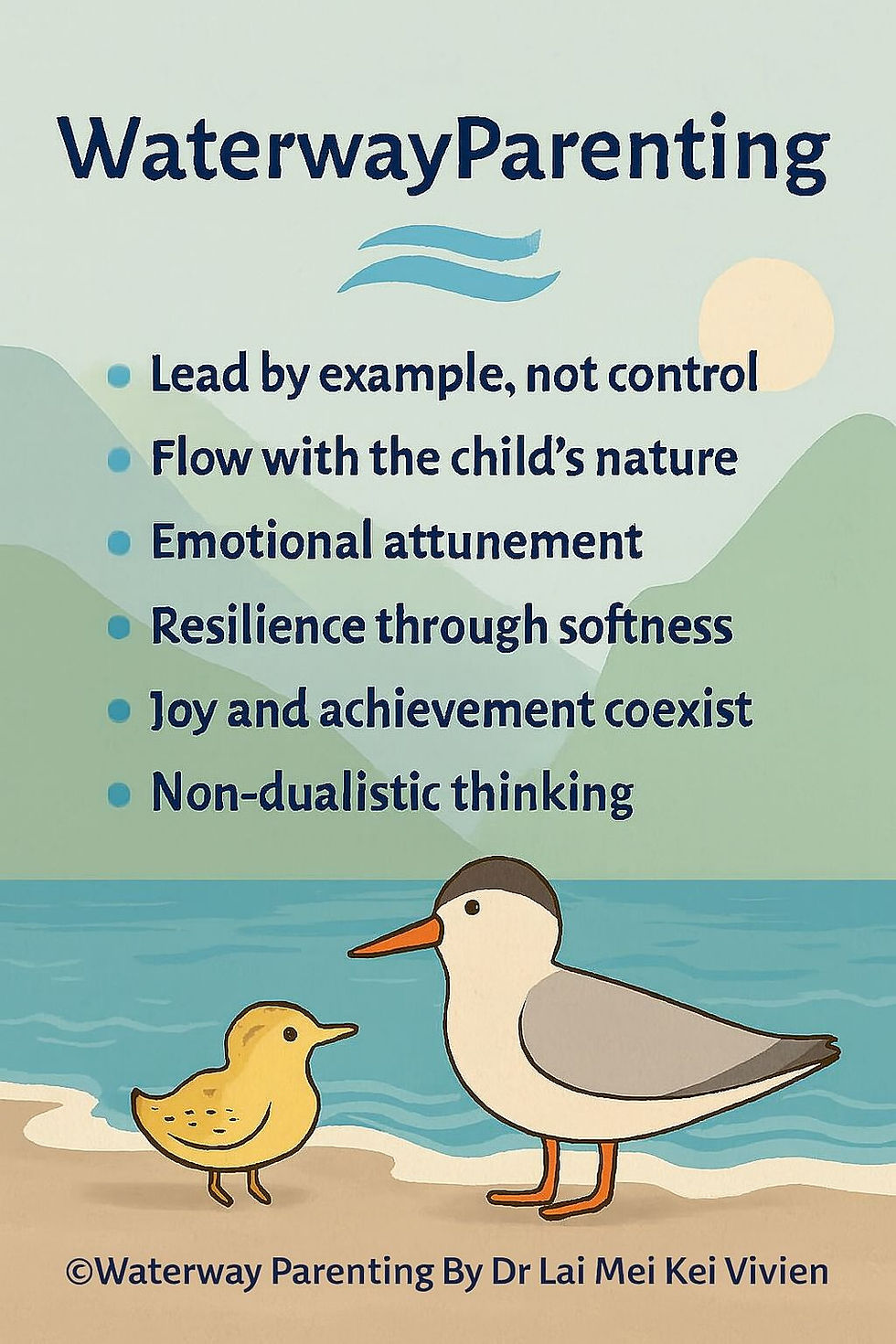Positive Parenting - Waterway Parenting Framework
- Dr. Lai

- Oct 14
- 3 min read
Updated: Oct 14
Flowing with Emotion: A Gentle Reframe of Parenting in Hong Kong
“When my child cries, resists, or feels lost, I don’t fix her—I flow with her.”
— Dr. Lai Mei Kei Vivien
This quote from Dr. Lai’s Waterway Parenting philosophy offers a profound shift in how parents respond to their children’s emotional storms. It uses parallel structure and a powerful contrast between “fix” and “flow,” inviting Hong Kong parents to rethink how they engage with their children’s emotions.
Flowing With your child: The Water Metaphor
Flowing suggests movement, adaptability, and presence. Like water, we meet our child where she is—whether she’s sobbing, resisting, or feeling lost—and we move with her, not against her. This is the heart of Waterway Parenting: emotional attunement, not emotional suppression.
Real-Life Scenarios in Hong Kong: Fixing vs. Flowing
Let’s explore how this philosophy plays out in everyday parenting moments familiar to Hong Kong families.
Scenario 1: Crying After Finishing School (Primary 4 Student)
Fixing Response (Angry and Emotional Tone)
“You just got back from school and you're crying again? I'm exhausted too—working all day, running this household, and still holding everything together! Do you think I have time to cry? No—I keep going because I have to. You have homework to finish, so stop wasting time with tears. Life isn’t always easy. Just deal with it!”
Impact:
This response reflects a moment of parental burnout, common in high-pressure environments like Hong Kong. But to a child, it may feel like:
- Their emotions are invalidated or shamed
- They must suppress or hide their emotions—like sadness, fear, or frustration—in order to be seen as good, strong, or worthy of approval.
- They’re emotionally disconnected from their caregiver
Over time, this can lead to:
- Emotional shutdown
- Fear of expressing feelings
- Internalized stress and anxiety
Flowing Response:
“I know you’re tired after school. I’m tired too—I’ve had a long day taking care of work and family. But I’m here with you. Let’s take a short break, then we’ll figure out how to start your homework together. You’re not alone.”
Impact:
This response acknowledges both your exhaustion and your child’s. It models emotional balance and teaches:
- Empathy without losing structure
- Shared responsibility with support
- Emotional safety alongside expectations
Scenario 2: Angry and Refusing Homework (After Cram School)
Fixing Shout (Escalated):
“Enough! You just came back from tutorial class and you still don’t want to study? You think Form 1 is going to be easy?”
Impact:
This response may force compliance, but it damages emotional safety. The child feels unheard and possibly ashamed. It can lead to:
- Power struggles
- Emotional withdrawal
- Resistance to future tasks
Flowing Response:
“I can see you’re really tired and frustrated. Let’s take a short break and talk about what’s making this hard. I’ll help you plan how to finish it.”
Impact:
You’re still holding a boundary, but you’re doing it with empathy. You’re teaching emotional regulation by modeling it. The child feels:
- Respected and supported
- More willing to engage
- Empowered to try again
Scenario 3: Feeling Lost and Overwhelmed While Doing Homework (Before TSA Exams)
Fixing Shout (Reactive & Controlling):
“Why are you acting like this? It’s just revision! Stop crying and focus already! You’re wasting time and making this harder than it is!”
Impact:
This kind of response may come from a place of urgency or stress, especially during exam season. But it sends the message that the child’s emotions are inconvenient or unacceptable. It can lead to:
- Emotional shutdown
- Increased anxiety or shame
- Resistance or avoidance of future tasks
- Strained parent-child connection, where fear replaces trust
Flowing Response:
“This worksheet looks really confusing. It’s okay to feel stuck. Let’s take a breath together, and then we’ll figure out the first step. I’m here with you.”
Impact:
This response validates the child’s feelings, offers calm support, and models problem-solving through connection. It doesn’t ignore the task—it simply prioritizes emotional regulation first. The child feels:
- Safe to ask for help
- Less overwhelmed
- More capable of moving forward
Why Dr. Lai’s Waterway Parenting Approach Matters in Hong Kong
In a city where academic achievement and social expectations often dominate parenting decisions, Waterway Parenting offers a refreshing alternative. When we flow with our children:
- We build trust and emotional safety
- We teach resilience through connection
- We help them feel seen, not shamed
- We strengthen the parent-child bond
- We nurture a happy, growth-minded child
This doesn’t mean we abandon discipline or goals—it means we lead with empathy, and guide with presence.
At its core, Waterway Parenting is about moving with—not against—our children’s emotional currents. Like water, we adapt, support, and shape with gentle strength. We don’t force growth; we nurture it.
Copyright © Dr. Lai Mei Kei Vivien. “Waterway Parenting” — All rights reserved.


Comments